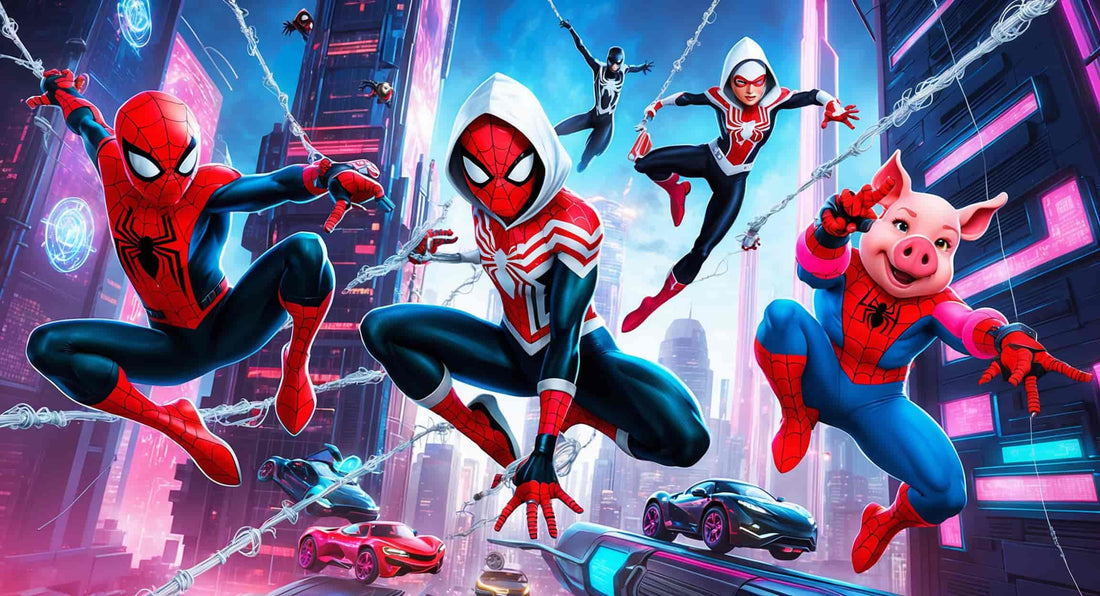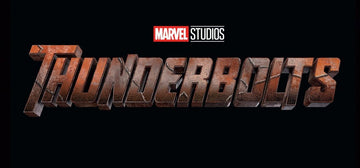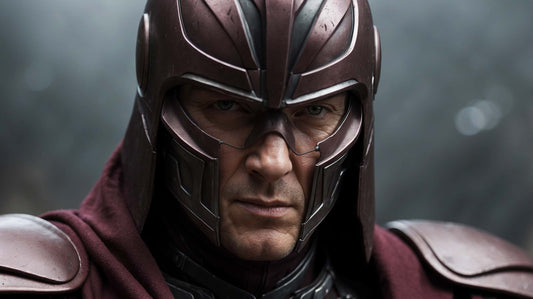
We tell you all you need to know about the SpiderVerse
SpiderMan begins its narrative in the multiverse
Why is the Spider-Verse the best place to solve a problem?
With hundreds of versions of Spider-Man, one of them always ends up “hanging on” to the solution!
The SpiderVerse is not only a captivating narrative concept, but also an incredible opportunity to explore the diversity of characters and stories while deepening the legacy of the iconic hero.
What is the SpiderVerse?
The SpiderVerse is a set of parallel universes, where different versions of Spider-Man coexist, each with its own history and specificities. First appearing in comic books, this universe was popularized by animation with Spider-Man: Into the Spider-Verse in 2018.
This extends the Spider-Man universe far beyond Peter Parker. Characters like Miles Morales, Spider-Gwen and even more eccentric interpretations like Spider-Ham add a comic dimension to an already complex and sometimes rather serious universe about the Marvel universe's sense of responsibility. Each of these versions offers a different point of view, allowing us to tackle a variety of themes, such as cultural diversity, gender identity, and the different social struggles reflected in each character.
The strength of the Spider-Verse lies in its ability to tell universal stories that resonate with audiences of all backgrounds, while exploring more specific ideas through the adaptation of these different characters. For example, Miles Morales, the first Afro-Latino Spider-Man, has breathed new life into the character and the narrative, highlighting modern themes such as multiculturalism and adolescence in an increasingly connected and complex world.
The main interest of Spider-Verse is the connection between these different versions of Spider-Man. Although each has its own reality, they are all linked by the Weaver, a mysterious entity that maintains the web of the multiverse. This makes for exciting and unexpected interactions between these different Spider-Men, as when they have to unite to face common threats across the multiverse.

How was the SpiderVerse created ?
The concept of the SpiderVerse originated in the pages of Marvel comics in 2014. This comic book series, led by writer Dan Slott, introduced the idea of a multiverse centered entirely on Spider-Man and his many variants. In the initial story arc, dozens of versions of Spider-Man were brought together to fight the Heirs, a family of totemic predators who stalk the Spider-Men across different realities.
The idea immediately captivated comic-book readers, and it was this same fascination that inspired the makers of the animated film Spider-Man : Into the Spider-Verse. The film brought the richness of this multiverse to the screen, introducing audiences to alternative versions of Spider-Man that had hitherto been known mainly to comic book readers.
The first film was a resounding success, not only for its innovative approach to visual style, but also for its ability to juggle themes as varied as diversity, self-acceptance and family. Spider-Man : Across the Spider-Verse (2023) continued this momentum by continuing to explore these multiple realities, while introducing new incarnations of Spider-Man and more complex challenges for the characters.
Are the Spider-Verse and the Multiverse the same thing ?
Although the SpiderVerse is an integral part of Marvel's multiverse, it's important to note that the latter encompasses a wider variety of characters and stories. The multiverse in general refers to the set of parallel universes where different heroes and villains exist in various forms. This includes not only Spider-Man, but also alternate versions of the Avengers, X-Men and other major Marvel figures.
The Spider-Verse, on the other hand, focuses solely on alternative versions of Spider-Man. It's this particular aspect that makes it possible to develop a narrative framework focused exclusively on Spider-Man-related themes, without interference from other major Marvel franchises. The various Spider-Men are all connected by the Web of Life and Destiny, an artifact that links each Spider-Man across the multiverse and plays a crucial role in their shared destiny.
In this way, the Spider-Verse represents a microcosm of Marvel's larger multiverse, but is distinguished by its focus on the multiple incarnations of Spider-Man. Each character in the Spider-Verse has his or her own dynamic, but they all share a common heritage and mission: to protect the web and confront enemies such as the Heirs, who threaten the balance of this fragile structure.

Why is Miles Morales the original anomaly ?
Miles Morales is a central character in the SpiderVerse. First introduced in 2011, he quickly gained popularity as the new Spider-Man. However, what makes him truly unique within the Spider-Verse is that he is often described as an “anomaly” in the multiverse. Unlike other versions of Spider-Man, Miles Morales wasn't meant to become Spider-Man in his universe.
In his world, Peter Parker already exists as Spider-Man, and that's what makes Miles' story so interesting. His version of Spider-Man is born out of an incident that should never have happened, upsetting the character's usual dynamics in the multiverse. This anomaly makes Miles a central figure in Spider-Man's multiverse narratives, and his role continues to expand in the stories that take place there.
What's more, Miles' journey is a reflection of his quest for identity. As an Afro-Latino teenager, he faces challenges that Peter Parker has never had to face. His powers, like his role as Spider-Man, are intrinsically linked to his desire to find his place, not only as a superhero, but also as an individual in a complex society. He thus embodies a new horizon for the Spider-Man legacy, adding elements of diversity and inclusion that resonate with a modern audience.
A Multiverse of possibilities and SpiderMan diversity
In the SpiderVerse, each version of SpiderMan has its own characteristics and challenges. Notable characters include:
- • Peter Parker : The original Spider-Man, often faced with moral dilemmas and superhero responsibilities.
- • Miles Morales : A Hispanic-African-American teenager who embodies a new era for Spider-Man, with themes of diversity and identity.
- • Gwen Stacy : A female version of Spider-Man that brings a different dynamic and stories centered on female power.
- • SpiderMan Noir : An interpretation inspired by film noir, adding a retro touch and elements of mystery.
- • Iron-Spider : First appearing in The Amazing Spider-Man comics, Tony Stark created the Iron Spiderman suit for Peter Park, bringing to the forefront for the first time a SpiderMan equipped with armor, giving him unrivalled technological protection, agility and natural strength. The concept of the SpiderMan in armor will be revived with the launch of the Marvel film No Way Home, starring Tom Holland.
These characters, each with their own stories and struggles, enrich the narrative and visual universe of the SpiderVerse, allowing fans to explore a variety of narratives. The incredible success of the SpiderVerse lies in its ability to merge varied and sometimes totally opposite incarnations of SpiderMan, while preserving the fundamental essence of the character: an ordinary individual endowed with extraordinary abilities, engaged in a fight to establish justice. The multitude of SpiderMan versions contributes to the richness and appeal of the concept, appealing to a wide audience of all ages and cultures.
In SpiderMan: Across the SpiderVerse, the animated universe extends across a multiverse populated by numerous versions of SpiderMan, each with its own distinct visual style. For example, SpiderGwen's world is marked by soft pastels and visible brushstrokes, while SpiderPunk looks like something straight out of an underground fanzine. This visual contrast reinforces the unique identity of each character. Unlike traditional MCU films, dominated by special effects, Across the SpiderVerse looks like a comic-book sketchbook come to life. A visual approach that captures the very essence of creativity in the world of comic books.

Parallel worlds have the advantage of being able to rewrite a new SpiderMan story at will, giving a different vision of this iconic character that everyone loves.
Do the Avengers exist in the Spider-Verse?
Although the Spider-Verse is a dimension in its own right in Marvel's multiverse, it doesn't rule out the existence of the Avengers. However, in Spider-Verse stories, the Avengers generally play only a minor role, if not absent altogether. This allows the story to focus entirely on the different versions of Spider-Man and the specific threats they face.
In some Spider-Verse realities, alternate versions of the Avengers exist, but they have no major influence on the main events of the Spider-Man multiverse. For example, Spider-UK, a member of the Captain Britain Corps, collaborates with different versions of Spider-Man to protect the web of the multiverse, but this is an alternative version of a hero who is not a member of the Avengers in the mainline Marvel comics.
Interactions between SpiderMan and the Avengers are often limited to specific realities, and although they may appear in side stories, their involvement remains relatively small within the Spider-Verse. This gives Spider-Man narrative autonomy, which is crucial for exploring the different versions of his character.
Anyone can wear the mask
One of the central messages of the Spider-Verse is that anyone can become a hero. In the film Spider-Man: Into the Spider-Verse, this idea is symbolized by the famous slogan "Anyone can wear the mask". This reinforces the idea that the role of Spider-Man is not reserved for just one person, but can be taken on by anyone with the will and strength.
This theme of inclusion is one of the pillars of the Spider-Verse's success. Whether you're a teenager like Miles Morales, a young woman like Spider-Gwen, or even an anthropomorphic version like Spider-Pig, the essence of Spider-Man remains the same: an ordinary hero with great power and responsibility.
By the MySuperSuit team.





